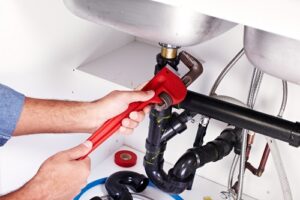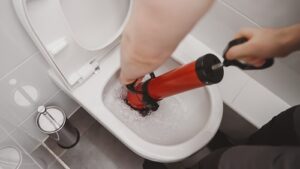Although we may not like to think about it, The toilet and related systems are some of the most important appliances in our homes that gives us a higher quality of life that often goes overlooked. The only exception to this is when a toilet is broken or not working properly, then people start to notice how important the toilet in their home truly is.
Toilets, and water appliances in general, are akin to complex machines like automobiles. They have many parts that make the item functional, and if any of these parts are starting to wear out, or they break down, it can cause the system to not function as it once did
Toilet problems can manifest in different ways. Some problems may make the functionality of the toilet a little different but still functional, while others will make the toilet not usable at all.
If you are a homeowner who is starting to notice something is not right with one or more toilets in your home, you should consider getting a professional plumber to come out and assess the situation. Until then, not too many people know how they should handle their problematic toilet, or if they should touch it at all while they are waiting for a professional to come out.
Inspect the Toilet Tank
Not all toilet problems are caused by the same issue, and at first it may not seem obvious as to what the problem is. More often than not, if a homeowner cannot physically see a problem with their toilet, usually the problem will be in the tank of the toilet. People should know that looking into the back of a toilet tank is not as intimidating as they might think.
Here is a general guideline that homeowners can practice when they are inspecting their toilet tank:
- Turn off the water supply: Before inspecting the tank, it’s essential to shut off the water supply to avoid any accidental flushing or flooding. Locate the shut-off valve behind or near the base of the toilet and turn it clockwise to stop the water flow.
- Remove the tank lid: Carefully lift the tank lid off the toilet tank and set it aside on a stable surface. Be cautious as the lid may be heavy or fragile.
- Check the water level: Look inside the tank to determine the water level. The water level should be about an inch below the top of the overflow tube. If the water level is too high or too low, it can cause flushing issues.
- Inspect the flapper valve: The flapper valve is a rubber mechanism at the bottom of the tank that controls the water flow during flushing. Check if the flapper valve is properly aligned and not warped, cracked, or covered in mineral deposits. Ensure that it forms a tight seal when closed and opens fully when the flush lever is activated.
- Examine the flush mechanism: The flush mechanism consists of the flush lever, lift arm, chain, and flapper valve. Verify that the chain connecting the flush lever to the flapper valve is properly attached and has enough slack for the flapper to close fully. Adjust the chain length if necessary.
- Look for leaks or cracks: Inspect the tank for any signs of leaks, cracks, or water damage. Check the bolts and gaskets connecting the tank to the bowl for tightness and signs of deterioration. Leakage can cause water wastage or damage to the surrounding area.
- Clean the tank: If you notice mineral deposits or debris inside the tank, use a sponge or cloth to clean the surfaces. Be cautious not to use any abrasive cleaners that could damage the components.
By inspecting the toilet tank, you can often identify common problems like a malfunctioning flapper valve, improper water level, or leaks. If you discover any significant issues that you’re unable to fix yourself, it’s advisable to seek the assistance of a professional plumber.
Toilet Problems That are Caused By Clogs
Probably the most common issue that a homeowner will experience that would cause their toilet to stop working properly as it once did is in the event of a clog. Toilet problems can be frustrating, but they can often be resolved with some basic steps and knowledge about clogs.
Keep in mind that if a clog is serious enough, it may not be able to be resolved by an individual themselves, and instead, they will need to call a professional plumber for assistance.
The first thing that someone should do if they are facing a clogged toilet is to get all necessary supplies. This is more than just a plunger, consider getting other items associated with home cleaning such as buckets and rags. These items will help you tack the clog effectively and minimize any potential mess.
- Assess the severity of the clog: Determine the severity of the clog by observing the water level in the bowl. If the water is rising dangerously high or if it shows no signs of draining, it may be a severe clog. In such cases, it’s recommended to call a professional plumber for assistance.
- Use a plunger: Start by using a plunger to clear the clog. Ensure there is enough water in the bowl to cover the rubber cup of the plunger. Place the plunger over the drain hole at the bottom of the bowl, creating a tight seal. Then, using an up-and-down motion, plunge vigorously for about 20 to 30 seconds. Repeat this process several times. The pressure created should dislodge the clog and allow the water to flow freely.
- Try an auger or plumbing snake: If the plunger doesn’t resolve the clog, you can use a toilet auger or plumbing snake. Insert the auger or snake into the toilet drain, following the manufacturer’s instructions. Rotate and push the auger or snake through the drain to break up or remove the clog. Be careful not to scratch or damage the toilet bowl with the tool.
- Avoid chemical drain cleaners: It’s generally advisable to avoid using chemical drain cleaners, as they can be harsh on your plumbing system and may cause damage. If the plunger and auger methods don’t work, it’s best to contact a professional plumber who can safely and effectively handle the situation.
- Take preventive measures: To prevent future clogs, be mindful of what you flush down the toilet. Avoid flushing items like wipes, sanitary products, cotton balls, or excessive amounts of toilet paper. These items can easily lead to clogs. Additionally, consider installing a drain screen or strainer over the drain to catch debris before it enters the pipes.
If you’re unable to resolve the clog on your own or if you’re uncomfortable attempting these methods, it’s recommended to seek professional help from a plumber. They have the necessary tools and expertise to handle more stubborn or complex clogs and ensure the proper functioning of your toilet.
Toilet Leaks and Fixes
Apart from toilet clogs, another common issue that many homeowners will have with their toilet is when it starts leaking water. Leaking water isn’t too much of a problem at first, and may seem more annoying than anything else, but as the issue gets worse, it can become more serious and harder to let go untreated.
A leaky toilet is something that can be caused by man different sources, so it is important for homeowners to check these different areas of their toilet having issues.
- Tighten connections: If you notice water seeping from the connections, start by tightening them. Use an adjustable wrench to carefully tighten the nuts connecting the supply line to the fill valve and the tank to the bowl. Be cautious not to overtighten and damage the fittings.
- Check the wax ring: If water is pooling around the base of the toilet, the wax ring located between the base of the toilet and the flange beneath it may be the culprit. This ring creates a watertight seal. If it’s worn out or damaged, water can seep out. To fix this, you’ll need to replace the wax ring. Shut off the water supply, remove the toilet, clean off the old wax ring, place the new wax ring on the flange, and re-install the toilet.
- Replace faulty components: If the leak persists, it may be due to faulty components within the toilet tank. Inspect the fill valve, flush valve, and flapper. Look for cracks, deterioration, or misalignment. If any components are damaged, replace them with new parts, following the manufacturer’s instructions.
- Check the tank bolts: Water leaks around the tank bolts may indicate loose or damaged bolts or washers. Drain the tank and remove the tank lid. Use a screwdriver and adjustable wrench to tighten the bolts connecting the tank to the bowl. If the washers are worn out or damaged, replace them.
- Inspect the flush valve: If the leak is occurring from the flush valve, it may need adjustment or replacement. Follow the manufacturer’s instructions to adjust the flush valve or replace it if necessary.
Test for leaks: Once you’ve addressed the potential causes of the leak, turn on the water supply and observe the toilet for any signs of leakage. Carefully monitor the base of the toilet, the connections, and the tank for several minutes to ensure there are no more leaks.
If you’re uncertain about any step or if the leak persists even after attempting these solutions, it’s recommended to contact a professional plumber. They can accurately diagnose the problem and provide expert assistance in resolving the toilet leak.
*Disclaimer: The views expressed here are those of the authors and do not necessarily represent or reflect the views of 1st Choice Plumbing*

